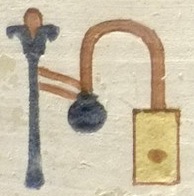



This page displays details of the selected Monument. Click on the Monument number to list all individual signs ("occurrences") recorded from that object or structure.
Monument : Wepemnefret G1201
Period : Dynasty IV
Reign(s) : Khufu
High Date : 2589
Low Date : 2566
Monument type : Slab stela
Localisation or provenance : Giza
References : PM III, 1, 57; Berkeley 6.19825; Smith (1949, 366-382); Der Manuelian (2003, 32-41; plate 1).
Wepemnefret was a son of Khufu. This slab stela is the best preserved of the three included here in the corpus. These stelae were placed in Old Kingdom tomb chapels, as can be seen in Der Manuelian’s experimental composite photo (2003, 35, plate 13). An unusual feature of these stelae is that the individual hieroglyphs are sometimes carved and sometimes simply painted (Der Manuelian 2003, plate 2). The choice of which style to adopt for a particular hieroglyph is inconsistent and therefore appears to be of no significance. This monument possesses some interesting occurrences. The sign Aa1 (a placenta?), consistently coloured green in the corpus from the Middle Kingdom onwards is here coloured yellow with red horizontal lines. This colour combination usually denotes something made of wood or cane-work basketry. Note, for instance, the identical yellow and red-lined stool Q3 which also becomes consistently green in later occurrences, as do the baskets V30 and V31. This would seem to suggest that Aa1 is in fact some sort of sieve or a round basket seen from above. For further discussion concerning the identification of this enigmatic sign, see the commentaries on the Aa group.